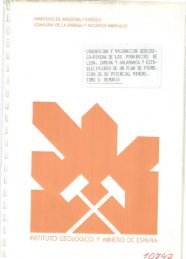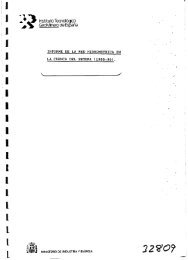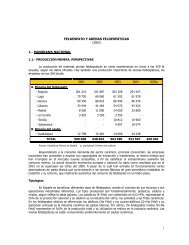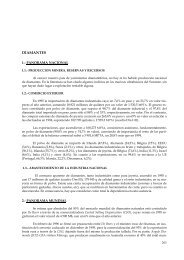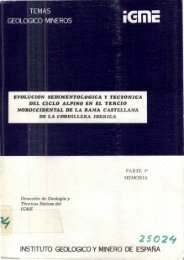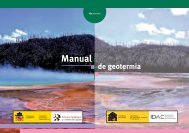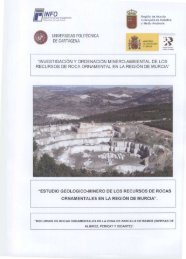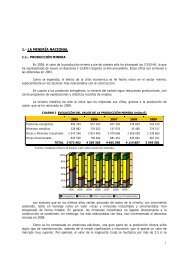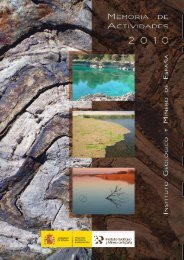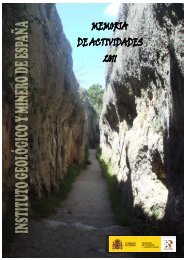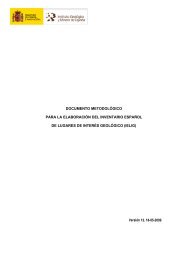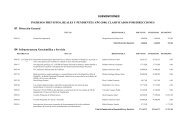mesozoic successions of the betic and iberian ranges - Instituto ...
mesozoic successions of the betic and iberian ranges - Instituto ...
mesozoic successions of the betic and iberian ranges - Instituto ...
You also want an ePaper? Increase the reach of your titles
YUMPU automatically turns print PDFs into web optimized ePapers that Google loves.
Range <strong>the</strong>re is no doubt about <strong>the</strong> influence <strong>of</strong> late-<br />
Variscan structures on Mesozoic sedimentation, since<br />
<strong>the</strong>y were re-activated in <strong>the</strong> subsequent extensional<br />
stage (Alpine Sedimentary Cycle). The beginning<br />
<strong>of</strong> Mesozoic sedimentation, unconformable upon<br />
Paleozoic rocks, corresponds to <strong>the</strong> classic Triassic<br />
Bunts<strong>and</strong>stein (siliciclastic sediments), Muschelkalk<br />
(carbonates) <strong>and</strong> Keuper (siliciclastic-evaporitic)<br />
German facies.<br />
On top <strong>of</strong> <strong>the</strong>se are Jurassic rocks corresponding<br />
to <strong>the</strong> carbonate sedimentation in extensive shelves<br />
protected by bioclastic bars <strong>and</strong> bioherms. The tectonic<br />
<strong>and</strong> sea level variations caused a great variety <strong>of</strong><br />
domains <strong>and</strong> facies, <strong>and</strong> <strong>the</strong> subsequent stratigraphic<br />
unconformities with plenty <strong>of</strong> hiatus as well as condensed<br />
levels, lesser in <strong>the</strong> Pre-Betic <strong>and</strong> more frequent<br />
in <strong>the</strong> External <strong>and</strong> Internal Sub-Betic (Molina,<br />
1987). In <strong>the</strong> Middle Sub-Betic, submarine volcanism<br />
brought strong bathymetric changes to <strong>the</strong> Jurassic<br />
basin, toge<strong>the</strong>r with local development <strong>of</strong> shallow<br />
carbonate shelves upon volcanic edifices considered to<br />
be guyots (Molina <strong>and</strong> Vera, 1999, 2001).<br />
At <strong>the</strong> beginning <strong>of</strong> <strong>the</strong> Cretaceous, <strong>the</strong> Pre-Betic<br />
Zone underwent <strong>the</strong> most important sedimentary<br />
stage <strong>of</strong> <strong>the</strong> Mesozoic, related to rifting processes in<br />
<strong>the</strong> North Atlantic, <strong>and</strong> determined by faults generated<br />
during this extensional period (Vilas, 2001). An<br />
important clastic input sets <strong>the</strong> beginning <strong>of</strong> <strong>the</strong> Lower<br />
Cretaceous (Figure 4). The Utrillas facies (Upper Albian)<br />
was deposited in coastal <strong>and</strong> fluvial environments,<br />
unconformably upon different Cretaceous <strong>and</strong> Jurassic<br />
units, evidently representing <strong>the</strong> post-rift deposits. The<br />
Upper Cretaceous rocks were deposited in a tectonic<br />
context which recorded <strong>the</strong> first compressive stages in<br />
<strong>the</strong> sou<strong>the</strong>rn Iberian margin, within a framework <strong>of</strong><br />
carbonate shelves. Similarly to <strong>the</strong> Jurassic sequence,<br />
<strong>the</strong> Cretaceous <strong>of</strong> <strong>the</strong> Sub-Betic Zone displays a great<br />
contrast <strong>of</strong> facies <strong>and</strong> thicknesses between <strong>the</strong> stratigraphic<br />
series <strong>of</strong> <strong>the</strong> different domains: prevailing<br />
limestone rocks <strong>and</strong> pelagic marls rich in ammonites,<br />
nanoplankton, radiolarians <strong>and</strong> foraminifera, <strong>and</strong> local<br />
interbeds <strong>of</strong> siliciclastic <strong>and</strong> carbonate turbidites. Near<br />
<strong>the</strong> Jurassic-Cretaceous boundary, <strong>the</strong>re is an unconformity<br />
recognizable throughout all <strong>the</strong> Pre-Betic, indicating<br />
a remarkable change in sedimentation.<br />
Seven places have been selected in <strong>the</strong> Betic Mountain<br />
Range based on <strong>the</strong>ir outst<strong>and</strong>ing values, which<br />
include <strong>the</strong> most interesting geological sites (geosites,<br />
Figure 5): “Cretaceous <strong>of</strong> Segura de la Sierra” <strong>and</strong><br />
“Lower Cretaceous carbonate shelves in <strong>the</strong> Jávea<br />
sector” (La Nao <strong>and</strong> San Antonio Capes, Alicante) in<br />
<strong>the</strong> Pre-Betic Zone; “Carbonate turbidites <strong>of</strong> <strong>the</strong><br />
Toril Formation” (Lower Jurassic) in <strong>the</strong> Intermediate<br />
Domain; “The “Ammonitico Rosso” facies <strong>of</strong><br />
Córdoba” <strong>and</strong> “Tectonic windows in <strong>the</strong> Sub-Betic<br />
(Carcabuey, Valdepeñas, Huelma, Cabra Santo<br />
Cristo)” in <strong>the</strong> External Sub-Betic; <strong>and</strong> “Marine<br />
volcanism <strong>and</strong> its relation to sedimentation”<br />
<strong>and</strong> “Slumps <strong>and</strong> related facies NE <strong>of</strong> Campillo<br />
de Arenas” in <strong>the</strong> Middle Sub-Betic. This selection<br />
Figure 4, above. Syn<strong>the</strong>tic paleogeographic crosssection<br />
for <strong>the</strong> Pre-Betic <strong>of</strong> <strong>the</strong> Sierra de Cazorla <strong>and</strong><br />
Segura. Pre-, syn- <strong>and</strong> post-rift stages refer to <strong>the</strong><br />
opening <strong>of</strong> <strong>the</strong> North Atlantic sea.<br />
Figure 5, below. Location <strong>of</strong> <strong>the</strong> geosites described in<br />
<strong>the</strong> text for <strong>the</strong> Betic Mountain Range:<br />
1) Segura de la Sierra.<br />
2) La Nao Cape – San Antonio Cape.<br />
3) Carbonate turbidites.<br />
4) Ammonitico rosso.<br />
5) Carcabuey, Valdepeñas, Huelma <strong>and</strong> Cabra Sto.<br />
Cristo tectonic windows.<br />
6) Volcanism <strong>and</strong> related sedimentation.<br />
7) Campillo de Arenas.<br />
76<br />
Castro, J.M. - García, A. - Gómez, J.J. - Goy, A. - Molina, J.M. - Ruíz Ortíz, P.A. - Sopeña, A.



